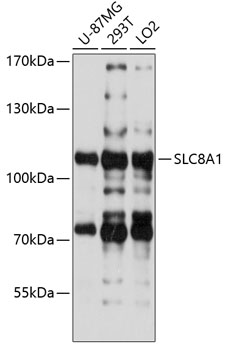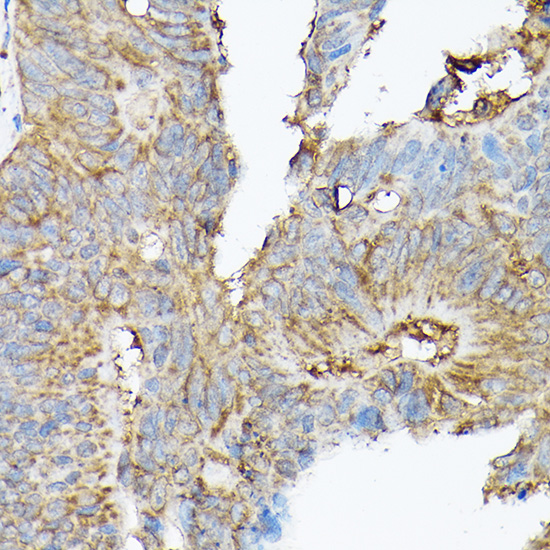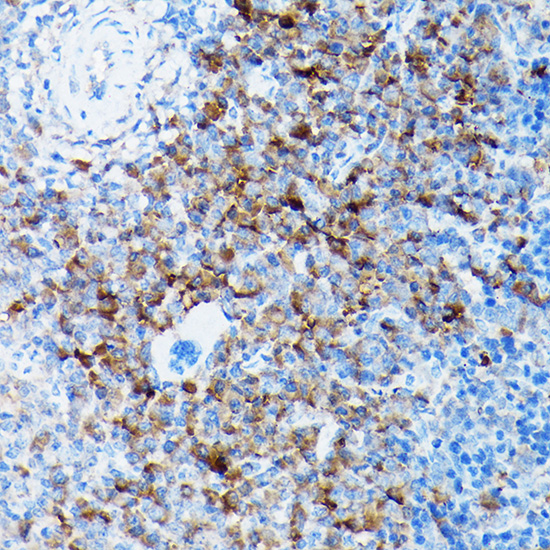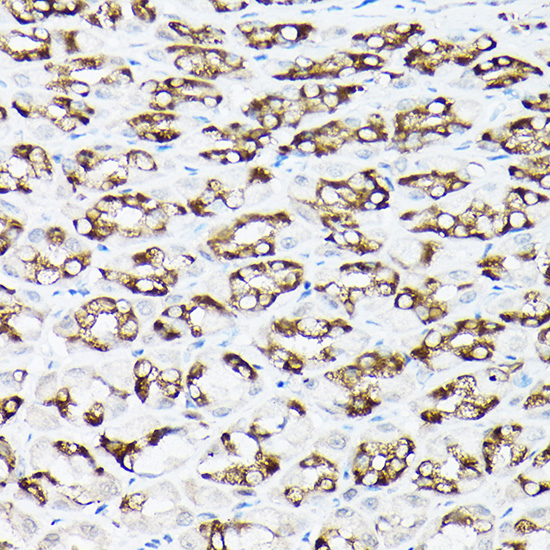Signal Transduction Antibodies 3
Anti-SLC8A1 Antibody (CAB5583)
- SKU:
- CAB5583
- Product Type:
- Antibody
- Reactivity:
- Human
- Reactivity:
- Mouse
- Reactivity:
- Rat
- Host Species:
- Rabbit
- Isotype:
- IgG
- Antibody Type:
- Polyclonal Antibody
- Research Area:
- Signal Transduction
Description
| Antibody Name: | Anti-SLC8A1 Antibody |
| Antibody SKU: | CAB5583 |
| Antibody Size: | 20uL, 50uL, 100uL |
| Application: | WB IHC |
| Reactivity: | Human, Mouse, Rat |
| Host Species: | Rabbit |
| Immunogen: | Recombinant fusion protein containing a sequence corresponding to amino acids 250-520 of human SLC8A1 (NP_066920.1). |
| Application: | WB IHC |
| Recommended Dilution: | WB 1:1000 - 1:2000 IHC 1:50 - 1:200 |
| Reactivity: | Human, Mouse, Rat |
| Positive Samples: | U-87MG, 293T, LO2 |
| Immunogen: | Recombinant fusion protein containing a sequence corresponding to amino acids 250-520 of human SLC8A1 (NP_066920.1). |
| Purification Method: | Affinity purification |
| Storage Buffer: | Store at -20'C. Avoid freeze / thaw cycles. Buffer: PBS with 0.02% sodium azide, 50% glycerol, pH7.3. |
| Isotype: | IgG |
| Sequence: | WVAD RRLL FYKY VYKR YRAG KQRG MIIE HEGD RPSS KTEI EMDG KVVN SHVE NFLD GALV LEVD ERDQ DDEE ARRE MARI LKEL KQKH PDKE IEQL IELA NYQV LSQQ QKSR AFYR IQAT RLMT GAGN ILKR HAAD QARK AVSM HEVN TEVT ENDP VSKI FFEQ GTYQ CLEN CGTV ALTI IRRG GDLT NTVF VDFR TEDG TANA GSDY EFTE GTVV FKPG DTQK EIRV GIID DDIF EEDE NFLV HLSN VKVS SEAS EDGI LEAN HVST LAC |
| Gene ID: | 6546 |
| Uniprot: | P32418 |
| Cellular Location: | Cell membrane, Multi-pass membrane protein |
| Calculated MW: | 104kDa/107kDa/108kDa |
| Observed MW: | 109kDa |
| Synonyms: | SLC8A1, NCX1 |
| Background: | In cardiac myocytes, Ca(2+) concentrations alternate between high levels during contraction and low levels during relaxation. The increase in Ca(2+) concentration during contraction is primarily due to release of Ca(2+) from intracellular stores. However, some Ca(2+) also enters the cell through the sarcolemma (plasma membrane). During relaxation, Ca(2+) is sequestered within the intracellular stores. To prevent overloading of intracellular stores, the Ca(2+) that entered across the sarcolemma must be extruded from the cell. The Na(+)-Ca(2+) exchanger is the primary mechanism by which the Ca(2+) is extruded from the cell during relaxation. In the heart, the exchanger may play a key role in digitalis action. The exchanger is the dominant mechanism in returning the cardiac myocyte to its resting state following excitation. |
| UniProt Protein Function: | NCX1: Rapidly transports Ca(2+) during excitation-contraction coupling. Ca(2+) is extruded from the cell during relaxation so as to prevent overloading of intracellular stores. Belongs to the sodium/potassium/calcium exchanger family. SLC8 subfamily. 4 isoforms of the human protein are produced by alternative splicing. |
| UniProt Protein Details: | Protein type:Motility/polarity/chemotaxis; Membrane protein, multi-pass; Transporter, SLC family; Membrane protein, integral; Transporter Chromosomal Location of Human Ortholog: 2p22.1 Cellular Component: integral to plasma membrane; plasma membrane; sarcolemma; T-tubule; Z disc Molecular Function:ankyrin binding; calcium ion binding; calcium:sodium antiporter activity; cytoskeletal protein binding; protein binding Biological Process: calcium ion homeostasis; cardiac muscle cell development; cardiac muscle contraction; cellular sodium ion homeostasis; ion transport; muscle contraction; positive regulation of bone mineralization; reduction of cytosolic calcium ion concentration; regulation of heart rate; regulation of the force of heart contraction; vascular smooth muscle contraction |
| NCBI Summary: | In cardiac myocytes, Ca(2+) concentrations alternate between high levels during contraction and low levels during relaxation. The increase in Ca(2+) concentration during contraction is primarily due to release of Ca(2+) from intracellular stores. However, some Ca(2+) also enters the cell through the sarcolemma (plasma membrane). During relaxation, Ca(2+) is sequestered within the intracellular stores. To prevent overloading of intracellular stores, the Ca(2+) that entered across the sarcolemma must be extruded from the cell. The Na(+)-Ca(2+) exchanger is the primary mechanism by which the Ca(2+) is extruded from the cell during relaxation. In the heart, the exchanger may play a key role in digitalis action. The exchanger is the dominant mechanism in returning the cardiac myocyte to its resting state following excitation.[supplied by OMIM, Apr 2004] |
| UniProt Code: | P32418 |
| NCBI GenInfo Identifier: | 12644210 |
| NCBI Gene ID: | 6546 |
| NCBI Accession: | P32418.3 |
| UniProt Secondary Accession: | P32418,O95849, Q4QQG6, Q587I6, Q59GN4, Q9UBL8, Q9UD55 Q9UDN1, Q9UDN2, Q9UKX6, A8K6N1, D6W595, |
| UniProt Related Accession: | P32418 |
| Molecular Weight: | 107,938 Da |
| NCBI Full Name: | Sodium/calcium exchanger 1 |
| NCBI Synonym Full Names: | solute carrier family 8 member A1 |
| NCBI Official Symbol: | SLC8A1 |
| NCBI Official Synonym Symbols: | NCX1 |
| NCBI Protein Information: | sodium/calcium exchanger 1 |
| UniProt Protein Name: | Sodium/calcium exchanger 1 |
| UniProt Synonym Protein Names: | Na(+)/Ca(2+)-exchange protein 1; Solute carrier family 8 member 1 |
| Protein Family: | Sodium/calcium exchanger |
| UniProt Gene Name: | SLC8A1 |
| UniProt Entry Name: | NAC1_HUMAN |










